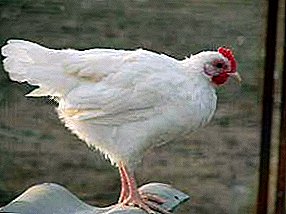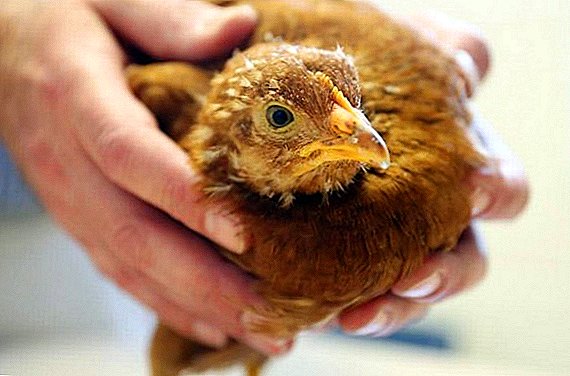 The danger of infectious diseases is that the defeat is detected late, and by that time most of the herd is infected. Such diseases lead to a large percentage of the death of chickens.
The danger of infectious diseases is that the defeat is detected late, and by that time most of the herd is infected. Such diseases lead to a large percentage of the death of chickens.
Tuberculosis in poultry is rarely observed. The main danger of the disease is that it can be transmitted to humans, various animals and birds, as well as the reverse process. How to treat and whether it is possible to prevent the disease, find out in this article.
What is chicken tuberculosis?
Avian tuberculosis is an infectious disease that occurs in a very severe form. Its causative agent is the bird flu tuberculosis bacterium. The main source of infection is bird manure. In it bacilli can remain up to 7 months.
For the disease is characterized by the formation of tubercles in the tissues of the body. Bacteria most often affect internal organs:
- mucous membranes;
- liver;
- gastrointestinal tract;
- the spleen.

The disease can last several months. Its course depends on the degree of damage to the internal organs, and the speed depends on the presence of immunity and the quality of nutrition of chickens. The development of tubercles causes an increase in the affected organ and ends with its rupture and lethal hemorrhage.
Did you know? In large farms and in poultry farms, chickens do not suffer from tuberculosis, as the livestock is replaced after 1-2 years and the disease does not often affect birds. Besides, to strengthen the immune system Chickens get vitamins and minerals in large quantities.
Causes
Presumably, the observed form of damage to the internal organs of the bacillus Mycobacterium avium is due to the characteristics of some components of the cells.
The main reason for the infection of domestic chickens is contact with pathogen carriers and their metabolic products. Pigeons and sparrows can be infected with Mycobacterium avium. Eating from poultry feeders, they infect water or food, passing the pathogen to healthy chickens.

If the carcasses of an infected bird were not destroyed, but were thrown into a landfill or buried, then wild animals, including rodents, easily find them, and also transfer the pathogen to uninfected areas.
Symptoms and course of the disease
Sick chickens are weakened, passive, quickly tired, lose muscle mass. At the same time they consume the usual amount of feed. The skin looks dry, and the earlobes and comb get an unhealthy shade. Along with the main symptoms, also note:
- intestinal disorders;
- gradual decrease in egg production;
- anemia;
- ruffled and dirty feathers.
Learn how to distinguish avian flu, infectious laryngotracheitis, salmonellosis, Marek's disease, aspergillosis, mycoplasmosis, coccidiosis, infectious bronchitis, a syndrome of egg production, conjunctivitis, salpingitis.
As the number of granulomas increases, the size of the affected organ increases. Outwardly, this can only be noted if there was a lesion of the intestinal mucosa and part of it protrudes from the esophagus. Palpating chicken can also be groped by granulomas.

For the internal systems of the body are characterized by:
- malfunction;
- joint damage;
- the appearance of tumors and abscesses;
- mucosal lesion.
Also the bird develops lameness and jumping gait. This happens with a lesion of the scapular zone, which becomes arthritis and paralysis of the paws.
Important! If a sick chicken is found in the herd, it is removed, and all chickens are placed in quarantine for 60 days. From the quarantine farm, you cannot sell meat and eggs.
Diagnosis and pathological changes
The veterinarians can confirm or deny the diagnosis during a laboratory examination of a sick bird, and the sooner it is carried out, the more chances to prevent the disease from spreading to the entire flock.
The primary diagnosis is established by external signs of the disease, as well as by the results of the detection of acid-resistant bacterial cells in smears.

An intradermal test of tuberculin is undertaken for the mass diagnosis of the herd. The test is done on open areas of the body - scallop, earrings. Weakened allergen Mycobacterium avium is administered intradermally.
If the inflammatory process has begun, the earring increases in size, this means that the reaction to the pathogen is positive, which indicates that the contact with the bacterium has taken place. If infection at the moment of contact did not occur, then a repeated tuberculin test after a month will give a negative result.
When the carcass of a dead chicken is opened, granulomas on the affected organs will definitely be found. But they are easily confused with oncological diseases, and an analysis to identify acid-resistant bacterial cells is needed to confirm the diagnosis.
Important! When in contact with birds and equipment, observe safety precautions. Use gloves and cotton gauze bandage.
What is the treatment of domestic chickens for tuberculosis?
Domestic chicken is not treated for tuberculosis due to economic inexpediency. For birds of rare breeds apply antibiotic treatment. The course of treatment will last at least 1.5 years.
 Leaving a sick chicken, there is a risk to infect all livestock.
Leaving a sick chicken, there is a risk to infect all livestock.
The diseased chicken must be destroyed, the chicken coop must be disinfected, and for the rest of the livestock, a tuberculin test should be carried out to identify infected birds. During the disinfection of the chicken coop, the birds must be relocated to another room, since the evaporation of some preparations, including lime, may be toxic to living organisms.
Learn how to disinfect a chicken coop.
Can I eat sick bird meat
The meat of a sick chicken is not only forbidden to be eaten, but it is not recommended to just throw it away or bury it. It is believed that it can be thoroughly boiled and fed to livestock, but if the pathogen persists for some reason, such food will simply infect healthy animals. The causative agent is resistant to aggressive environmental influences. In the soil and bird droppings, it can last about a year.
Is tuberculosis dangerous in humans?
Mycobacterium avium does not cause tuberculosis in humans, but is still dangerous, as it can be harmful to health. In addition, being a carrier of bacilli, a person may well infect healthy chickens or other animals.

Preventive measures
In order to prevent the use of "Ftivazid" - an anti-tuberculosis drug. The drug is available in pill form. The drug is added to feed the chickens. The dosage of the herd must be coordinated with veterinarians.
Did you know? In 1947, it was revealed that the causative agent of the disease affects the human body. The bacterium affects people regardless of their age and immune status.
Rodents and wild birds should not enter the room with food and drink, because they are the carriers of the disease. The disease is most susceptible to chickens in the cold season. Due to the accumulation of birds in a small area, the disease can very easily spread to all birds.
The room is disinfected with one of these solutions:
- bleach 3%;
- formaldehyde 3%;
- suspension of freshly sour lime 20%;
- caustic soda, sulfur-creosol mixture, etc.

From the occurrence of infectious diseases in birds it is impossible to be completely insured, but periodic preventive maintenance, keeping the chicken coop clean and not contacting wild birds or rodents reduce the risk of infection by 26%, according to Canadian researchers.
Tuberculosis in chickens: reviews
... Poultry suffer from tuberculosis at the age of 12 months and older ... When mycobacteria get into the body, primary nodules of grayish-white or yellowish-white color are formed, most often in the ileo-cecal joint of the intestine and in the liver, less often in the spleen and very rarely in other organs ...
Still, tuberculosis does not look like. But viral, similar to your case, a lot of respiratory diseases. When trachea and lungs are affected. More often in these cases, the nose and trachea are clogged with mucus. Do you have such a thing?















